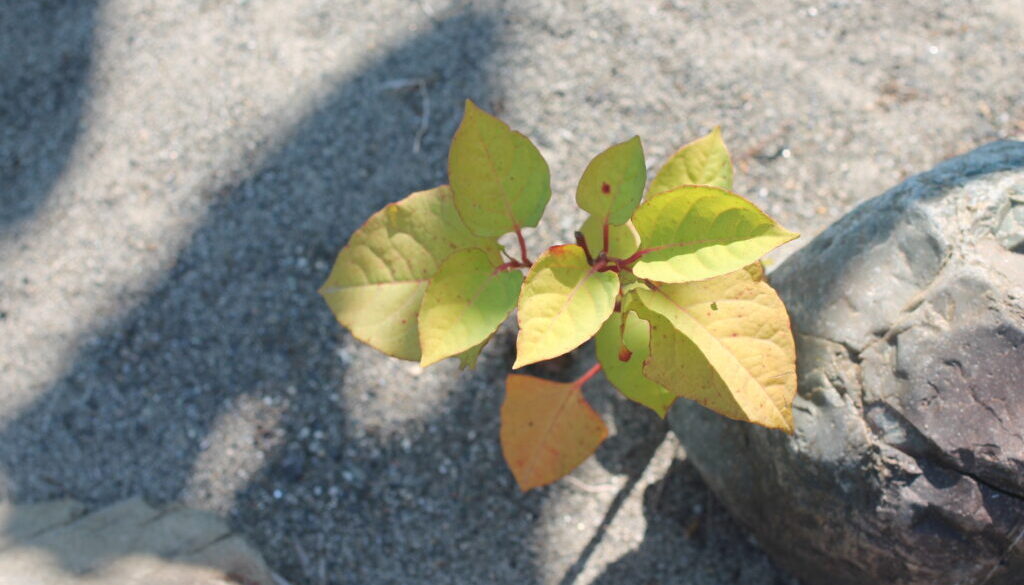Japanese Knotweed – A History of the World’s Worst Plant
Written by Maria Goncharova, edited by Hannah Munnalall
Japanese knotweed’s story follows an innocent plant which was forcefully pulled from its native habitat and placed into new territories, causing it to turn into an alien monster infecting the world globally.
Knotweed was originally found near riverbanks and forests in China, Japan, and Korea. In its natural habitat, the plant was not considered invasive, as the surrounding biota competed for space, light, and resources2.
However, once it brought to Europe and North America, these natural pressures no longer existed. Japanese knotweed first got its scientific name in 1777 when a dried sample was brought from Japan to a Dutch doctor and naturalist named Maarten Houttuyn, who first described the plant as Reynoutria japonica3.
In 1842, Phillipe von Siebold, a doctor who worked at the Dutch trading settlement in Japan, returned from his expedition back to Europe and brought with him the first live samples of Japanese knotweed, which he named Polygonum cuspidatum. Siebold founded the Royal Society for Encouragement of Horticulture, which held a monopoly for any import of knotweed.
By 1847, this plant won a gold medal for being the most interesting ornamental plant and was advertised as a plant with edible stems that could protect surrounding plants from wind and sun3. Additionally, Japanese knotweed was marketed as Japanese and Chinese herbal medicine.
With rising popularity, in 1848, knotweed became commercially available in Europe and started appearing in gardens and nurseries of European countries such as France, Britain, and Scotland4. The spread did not stop there. By 1868, reports of Japanese knotweed were coming from North America3.
It did not take long for Europe to experience the harshness of the invasive plant. By 1883, one of Siebold’s gardens in Leiden was overrun by the weed and turned into a jungle of knotweed3.
Japanese knotweed started being recognized as a weed only in the 1920s, but by then, the consequences of the previous introductions had already grown out of hand6.
By the 1930s Japanese knotweed was considered “Hancock’s Curse,” as the presence of this plant caused the devaluation of house prices3. By the 1950s, the plant had a grasp in Australia, reaching global invasion1.
As countries recognized the detrimental consequences of knotweed’s introduction, governments started to battle against this plant. In the United Kingdom, the Wildlife and Countryside Act in 1981 listed spreading and introducing knotweed as a punishable offense3.
This further led to Britain introducing the Environmental Protection Act in 1990, which sent a message nationwide to dedicate time and resources into the eradication of knotweed2.
However, efforts to eradicate Japanese knotweed were not successful; in 1999, the International Union for Conservation of Nature (IUCN) named Japanese knotweed as one of the world’s worst invasive plant4.
Overall, the history of this alien plant demonstrates the importance of not underestimating a plant, as well as highlights the need for nations to find, manage, and eradicate this weed. If this problem is left unchanged, Canada might face the same consequences as Britain.
References
1Ainsworth N, Weiss J, Jacob H, Dodd J, Moore J (2002) Fallopia japonica (Houtt.) Ronse Decr. (Japanese knotweed) – an underrated threat to riparian zones in Australia. W: Proceedings of 13th Australian Weeds Conference, Perth (Australia) pp. 130-133
2Anthony L (2017) The aliens among us: how invasive species are transforming the planet and ourselves. Yale University Press
3Bailey JP, Conolly AP (2000) Prize-winners to pariahs: a history of Japanese knotweed s.l. (Polygonaceae) in the British Isles. Watsonia 23: 93–110.
4Lavoie C (2017) The impact of invasive knotweed species (Reynoutria spp.) on the environment: review and research perspectives. Biological Invasions 19(8) 2319.
5Thiébaut M, Nicolas S, Piola F (2020). “The fad for Polygonum will fade away!”: Historic aspects of the propagation and success in France of the Reynoutria complex based on archives. Botany Letters, 1-14.
6Tredici PD (2017) The introduction of Japanese knotweed, Reynoutria japonica, into North America. The Journal of the Torrey Botanical Society, 144(4), 406–416.




